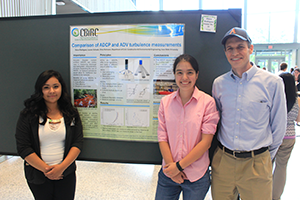
Diana Rodriguez, incoming senior at Hoover High School in Des Moines, Iowa, took advantage of an opportunity that most high school students don’t experience – develop research at Iowa State University.
Throughout summer 2015, Chris Rehmann, associate professor of civil, construction and environmental engineering at Iowa State, and Lauren Schwab, Iowa State master’s student in civil engineering, mentored Rodriguez on environmental engineering research. For six weeks, she developed an understanding of how river flow velocity can be measured and how those measurements apply to the spread of river contaminants.

In the lab Rodriguez used acoustic instruments in a test flume, located in Town Engineering Building, to measure water flow. She and Schwab worked together daily to detect changes in water flow velocity over time. “I enjoyed teaching Diana in ways she could comprehend at a graduate student level,” said Schwab, who earned her civil engineering bachelor’s degree at Iowa State in 2013.
On July 23, 2015, Rodriguez presented a research poster at the 14th Annual STEM Summer Institute, held at the Sukup Atrium, based on their findings. Their work will be compared to field river measurements to determine how contaminants move, spread, and become within safe range in a given waterway.
Rodriguez’s experience was part of the Young Engineers and Scientists (YES) program, which the Center for Biorenewable Chemicals (CBiRC), a National Science Foundation Engineering Research Center (NSF ERC) housed at Iowa State, hosts. Through YES, CBiRC supports 11th and 12th grade students as they partner with Iowa State faculty, staff and students on research projects. Rodriguez chose the 6-week summer option, but a 16-week academic year option also is available to high school students.
Rodriguez enjoyed studying the environment in her Advanced Placement (AP) environmental science course at Hoover High School. One day her teacher told her about the YES program and encouraged her to apply. The YES program required students to write a 500-word essay and pick a topic in engineering or biology. “Everything is connected: weather affects plant growth, which affects animal food, and so on,” Rodriguez said. “I wanted to do a hands-on project that let me work more in environmental science.”